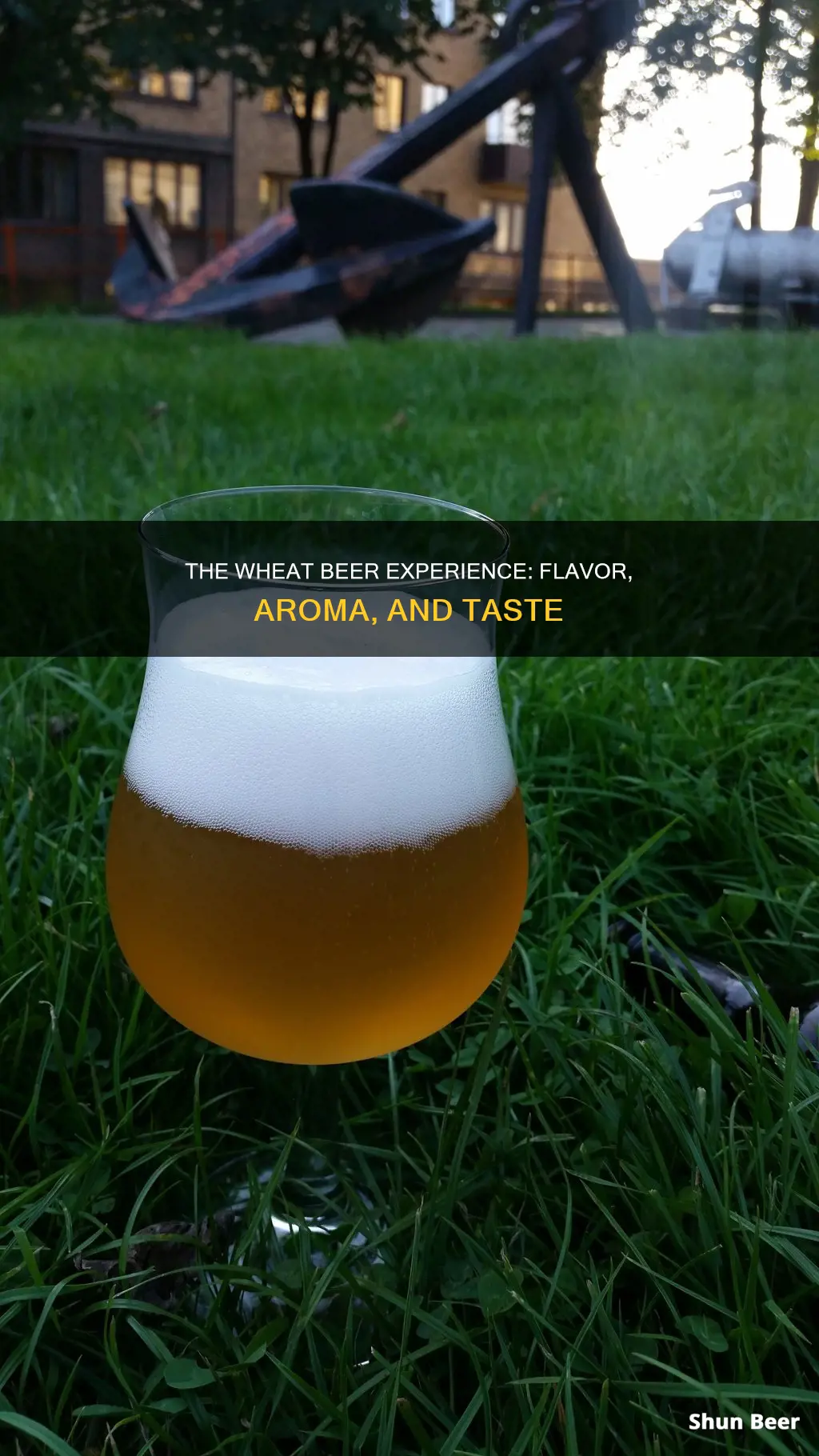
Wheat beer is a category of beer that typically uses at least 30% wheat in the brewing process and can be made using either ale or lager yeast. It is often light in colour, with low bitterness and alcohol content, and can be cloudy or clear in appearance. Wheat beers are known for their versatility, making them easy to pair with a wide variety of food options. They also vary in name according to where they are brewed and small variations in the recipe.
What You'll Learn

Wheat beer's appearance
Wheat beer is typically light in colour and can be cloudy or clear in appearance. The appearance of wheat beer varies depending on the style and brewing process.
American wheat beers, for example, can range from relatively clear to cloudy. They are brewed with at least 30% malted wheat and tend to be lighter in appearance. American wheat beers are known for their refreshing, crisp texture and noticeable hop character.
On the other hand, German wheat beers, such as Hefeweizen, are often unfiltered and have a cloudy appearance. Hefeweizen is a traditional Bavarian beer that gets its name from the German "Hefe", meaning yeast, and "Weizen", meaning wheat. The cloudiness in Hefeweizen comes from the suspended yeast and wheat proteins. This style of wheat beer typically has low hop bitterness and relatively high carbonation.
Belgian wheat beers, or Witbier, also tend to be cloudy or white in appearance due to the suspended yeast and wheat proteins. Witbiers are highly fermented and are typically brewed with coriander, citrus, or other spices, resulting in a bready, bright wheat flavour.
Minor varieties of wheat beer, such as Berliner Weisse, also have a cloudy appearance. This style of wheat beer is low in alcohol content and intentionally sour, with sweetened syrups of lemon, raspberry, or herbs often added before drinking.
Space Dust IPA: Wheat-Based Beer Mystery Solved
You may want to see also

Wheat beer's aroma
Wheat beers are known for their soft, bready, doughy, citrusy, and fruity aromas. The yeast used in wheat beer, such as Hefeweizen, often contributes banana, clove, and bubblegum notes that complement the citrusy and bready scent. The type of yeast used plays a significant role in the aroma profile, with ale yeast fermenting at warmer temperatures and producing stronger scents compared to lager yeast.
The presence of wheat gives wheat beers a distinct bready aroma, setting them apart from beers made primarily with barley, which tend to have maltier, caramelized, and roasted scents. Wheat beers are also often described as having citrusy notes, ranging from lemon and lime to sweet orange peel. These citrus characteristics can be attributed to specific hops used in the brewing process, such as Ahtanum, Chinook, Amarillo, Comet, and Cascade.
The hops used in wheat beers can also impart spicy notes, including white pepper, anise, licorice, and nutty flavours. Additionally, the fermentation process can introduce phenolic off-flavours, resulting in clove-like or smoky aromas. The combination of yeast, hops, and fermentation techniques creates a complex aroma profile in wheat beers.
The aroma of wheat beer is also influenced by the type of wheat used. Red wheat, for example, is known for having a slightly more flavourful profile. However, the most important characteristic to consider when selecting wheat for brewing is its protein content, as lower protein content generally results in better beer.
The addition of other ingredients, such as coriander and orange peel, can further enhance the aroma of wheat beers. These ingredients are commonly found in Belgian witbiers, adding sweet citrus and spice aromatics to the beer. Overall, the aroma of wheat beer is a complex interplay of the grains used, the yeast, hops, and any additional ingredients, resulting in a unique and captivating sensory experience.
Tiger Beer and Wheat: What's the Deal?
You may want to see also

Wheat beer's flavour
Wheat beer is a category of beer that typically uses at least 30% wheat in the brewing process and can be made using either ale or lager yeast. It is often light in colour, low to medium in alcohol content, and can be cloudy or clear in appearance. Wheat beers tend to be low in bitterness and easy to drink, with a light, flour-like character.
The flavour of wheat beer varies depending on the style and ingredients used. The two main varieties are German Weizenbier and Belgian Witbier, but other types include Lambic (made with wild yeast), Berliner Weisse (a cloudy, sour beer), and Gose (a sour, salty beer).
German Weizenbier, or Hefeweizen, is characterised by flavours of banana and clove, which are produced by the specialised yeast strains used during fermentation. Other flavours that may be present include vanilla, bubble gum, and sometimes citrus. American wheat beers, on the other hand, do not typically offer flavours of banana or clove, but may have a more noticeable hop character, resulting in a crisp texture.
Belgian Witbiers, or "white beers", are brewed with coriander and orange peel, resulting in subtle spicy notes. They are also often made with raw unmalted wheat, which gives them a cloudy or white appearance when cold.
Overall, wheat beers are known for their light, refreshing flavour profiles, making them easy to drink and pair with a variety of foods.
Exploring the World of Wheat Beers: Are All Brews Wheat-Based?
You may want to see also

Wheat beer's history
Wheat beer is believed to have been used as a grain for brewing since Babylonian times or earlier. Ancient Egyptian hieroglyphics found in several Egyptian tombs illustrate the use of two different grains. Wheat beer, as we know it today, likely originated in Bavaria, Germany, in the 15th century, though it was introduced to the region from neighbouring Bohemia.
Until 1548, only beer made from barley was allowed to be brewed in Bavaria, due to the 'Reinheitsgebot' law. This changed when William IV, Duke of Bavaria, gave Baron Hans VI von Degenberg special privileges to brew and sell wheat beer. The Degenberger clan held on to these exclusive rights for decades, until they died out, and the privilege was passed on to the Bavarian Dukes. In 1589, Bavarian Duke Maximillian I built the "Hofbräuhaus am Platzl", which still occupies the location of the Ducal Weissbier brewery.
Weissbier, or white beer in German, was the choice of drink for all citizens, noble or peasant. It is typically a top-fermented ale, using at least 30% wheat in the brewing process, and comes in a variety of styles. The most well-known wheat beer is Hefeweizen, a refreshing style from Germany that has gained popularity around the world. Wheat beers are usually light in colour, low to medium in alcohol content, and can be cloudy or clear. They are often brewed without hops and tend to lack bitterness, making them easy to drink.
In the mid-19th century, hardly anyone was drinking Weizenbiers, and by 1872, anyone could brew them, as production was no longer controlled by the royal government. The future of Weizenbier seemed in jeopardy again with the rising popularity of Bohemiam lager, but after World War II, Weizenbier rose in popularity once more. Today, Weizenbiers account for a significant portion of all beer sold in Bavaria and Germany.
Hefeweizen: Wheat Beer, But Different
You may want to see also

Wheat beer's food pairings
Wheat beers are incredibly versatile when it comes to food pairings. Their smooth texture and light carbonation make them a great match for a variety of dishes, especially those with citrus or fruity flavours.
For those who enjoy a bit of spice, Indian food and Thai noodle dishes are perfect companions for wheat beers. The carbonation and crispness of the beer help to balance out the heat of the spices, creating a refreshing contrast.
Wheat beers also pair beautifully with seafood, especially when it's simply prepared. Think fried or grilled sole, plaice, or even fish and chips. They are also a wonderful choice for seafood pastas and noodles, like crab linguine with chilli and coriander, or a pad Thai.
If you're craving something a little more indulgent, wheat beers go hand in hand with fruit-filled and fruit-flavoured desserts. Banana pudding, for example, would be a delightful pairing, bringing out the citrusy notes of the beer.
For something savoury, wheat beers are excellent with salads, particularly those with light citrus dressings and fresh cheeses like young goat's cheese, sheep's cheese, or feta. They also complement light Chinese dishes, such as stir-fries, and other Asian cuisines like dim sum.
So, whether you're in the mood for a spicy curry, a fresh seafood dish, or a sweet dessert, a wheat beer is an excellent choice to elevate your dining experience.
Wheat Malt for Beer: Grind or Not?
You may want to see also
Frequently asked questions
Wheat beer is a category of beer that typically uses at least 30% wheat in the brewing process and is often light in colour, low to medium in alcohol content, and can be cloudy or clear in appearance.
The two main varieties are German Weizenbier and Belgian Witbier. Other types include Lambic (made with wild yeast), Berliner Weisse (a cloudy, sour beer), and Gose (a sour and salty beer).
Wheat beers usually have a light aroma of hops with hints of citrus, clove, banana, and vanilla. They tend to lack bitterness, making them easy to drink.
Wheat beers are typically served at 45 to 50 degrees Fahrenheit in a flute or vase glass. The glass can be chilled beforehand or rinsed with cold water to prevent the formation of excess foam.
Wheat beers are very versatile and can be paired with a wide variety of foods, including salads, shellfish, cheeses, and fresh fruits and vegetables. They also go well with spicy dishes and desserts.







